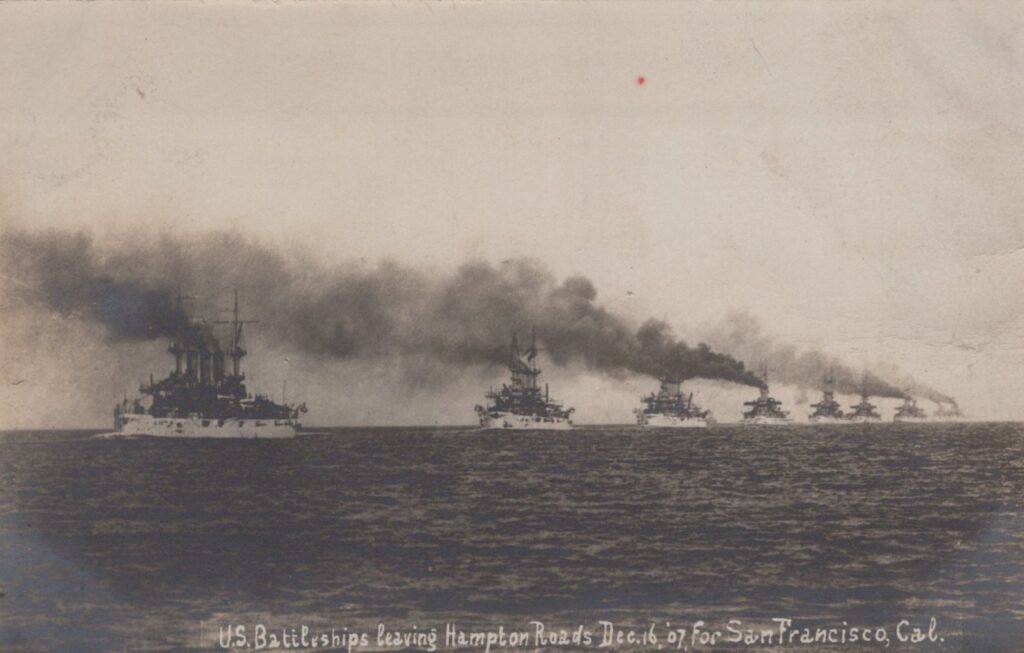Apologies, but no results were found for the requested archive. Perhaps searching will help find a related post.
underway from hampton roads heading for san francisco
The fleet had been slowing assembling in Hampton Roads for months. Battleships had undergone overhauls, sailors had trained in Cuba, and gunnery practice had been held along the Atlantic Coast. Now, just before Christmas they were ready for departure. On December 17th, 1907, hundreds of people lined the shore of Old Point Comfort, with the Chamberlin Hotel in the background to send the fleet off. (above - photographer unknown) President Roosevelt onboard the Mayflower, (seen in the center of the photo below), watched the ships pass in review as they set off on their journey around South America. It was still seven years before the Panama Canal would be finished and to get the Atlantic Fleet to the Pacific was a trip around the Horn.
"The sixteen great ships massed under the command of our veteran hero, Rear-Admiral Robley D. Evans, swung with precision into place and, passing the frowning ramparts of Fortress Monroe, began their journey to the Pacific. The warships moved in single column four-hundred yards apart, from masthead to masthead, and as the last one passed out through the entrance of Chesapeake Bay, they formed such massing of naval forces had ever been seen in American waters." (The photographs below are part of the same set from an unknow photographer)
"On board a U.S. Battleship" by Margret J. Codd

The fleet's departure from Hampton Roads was a grand celebration. Marine honor guards snapped to attention, salutes boomed out, and bands crashed into the national anthem as the ships passed in review before the presidential yacht Mayflower. Roosevelt was heard to say, "Did you ever see such a fleet and such a day?" With a wave of his top hat "By George, isn't it magnificent!"
They departed from Hampton Roads on a day when the sun showed through the clouds after three days of rain, with some questions as to the intent of the fleet when it arrived in the Pacific. Were we going to war with Japan? The sixteen battleships departed that morning not knowing that they would not return to Hampton Roads until 14-months later and 46,000 miles of steaming.
Built by J & G Thompson, of Clydebank, Scotland, the presidential Yacht was designed as a luxury steamer in 1896. Mayflower joined Admiral Sampon's squadron in Key West and sailed for Cuba to participate in the Spanish American War and later as the Flagship for Admiral Dewey. In 1905 she became the presidential yacht and received the Russian and Japanese delegation in Oyster Bay.


The fleet departed in a column spaced 400-yards apart, from masthead to masthead, with a length of three miles as they passed through the mouth of the Chesapeake Bay. For ten miles the Mayflower moved ahead of the battleships, then drew to one side, while the President stood on deck reviewing the fleet and receiving the salutes of the batteries from each ship in return. Fourteen thousand men had stared their historic voyage.
At right and left, two real photo postcards created the day before and the day of departure.

sailor and mascott, uss ohio
The photograph above shows a sailor with his billy goat mascot on board the USS Ohio. The card is labeled Hampton Roads and is canceled December 29, 1907 in Santa Anna, Iowa, which is a little strange, because it was sent to Indianapolis, Indiana?
The card at right shows the Main, Ohio, and Minnesota at Hampton Roads in October 1907 for the Jamestown Celebration.
The Pacific fleet (Flagship Connecticut in the lead) steaming out to sea. Underwood & Underwood Publishers
The ships changed their long line and the usual formation of the two squadrons. These were divided into four divisions of four ships each which were commanded by Admirals Evans, Emory, Thomas, and Sperry respectively. The squadrons were 1600-hundred yards apart and each boat was 800-yards behind the one proceeding.
In the words of Rear Admiral Robley D. Evans, this armada is ready for "a feast, a frolic, or a fight." A national hero, "Fighting Bob" was known not to shy away from a fight and fleet sailors were honored to serve under him as they departed on the cruise.
Below: Harpers Weekly "Too a Fight or a Frolic"















